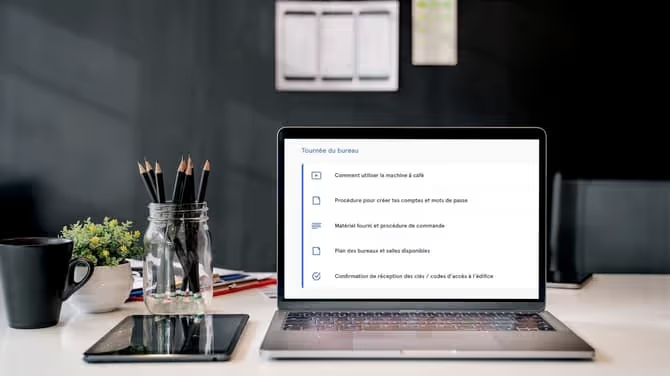10 ways to engage new hires starting from day one

Discover Workleap Officevibe's benchmark report on 12 key employee engagement metrics

This article is a guest post from Softstart, the all-in-one onboarding platform to start your new hires off on the right foot.
Companies who show genuine care with their employees by supporting new hires from the get-go, reap the benefits of higher levels of engagement—and up to 82% employee retention in the long run. The importance of good onboarding for employee engagement is evident, and there are plenty of sound reasons why engaging employees at an early stage is a worthwhile investment.
There are many ways to engage new hires. Applying engagement tactics from the start sets up a good foundation that will last the entirety of someone’s employment journey. We’ve listed out ten ways you can prioritize employee engagement for new hires, helping you maintain engagement more easily even after the onboarding phase of the employment cycle.
1. Prepare ahead of the first day
Naturally, you’ll want to welcome a new employee in the most organized context possible. Structure shows professionalism.
There are ways to make sure your new hire’s first day is as least chaotic as possible. For starters, getting administrative tasks out of the way before ensures your new hire can dedicate themselves entirely to their onboarding once they start. This could include:
- Sending the paperwork for new hires to read and sign by email one week before.
- Ensuring they have their new work computer and any equipment they need, along with access to tools and software.
- Providing additional onboarding documents, like an employee handbook, to support learning.
💡 We call this pre-boarding, and 35% of best-in-class companies are likely to apply this in their onboarding.
2. Make a great first day impression
First impressions last. By ensuring your new employee’s first day starts strong, you're helping set a positive tone and expectations from day one. We’re not talking about being prepared by just having a working laptop ready at their desk upon their arrival.
There’s a difference between doing the bare minimum and going the extra mile.
Why not buy them lunch on their first day? Or welcome them via a tagged company post on LinkedIn, or gift them a welcome package with office swag? Small extra efforts like these are sure to wow. Have no idea where to start? Here's some inspiration.
Softstart proposes first day activities like team building and prepping welcome packages to add pizzazz to all your onboardings.
3. Leverage employee benefits
While a job isn’t just about the money, the salary and employee benefits that come along with a new job play a crucial role in your new employee’s engagement.
81% of employees who can easily access their benefits report feeling loyal to their employer, and 79% report feeling proud to work for them.
Access Perks
We all can miss reading the fine print, so make sure your new hires understand the full extent of their compensation, including employee benefits and perks. Dedicate time during the orientation session to discuss, or the subject may deserve a whole session of its own. Your new hires might not know that they can get 30% off on their annual public transport pass thanks to working for you, for example, and that’s a huge plus!
4. Highlight company culture
The same way you would for compensation, highlighting the added value of an awesome company culture impacts how you’ll engage your new hires. The lure of strong company culture is becoming even more major for remote or hybrid work environments.
Share details on:
- What the company culture stands for (like a team-first culture).
- Shared employee values (like collaboration).
- How it’s all put into practice, regardless of the workplace setting (like an open-door policy at the office, or dedicated communication channels, or tools to express concerns virtually).
Communicate company culture throughout orientation to inspire a sense of community within the new hire.
People who are motivated by their company's values also tend to enjoy their work more, according to Officevibe's Pulse Survey data.
5. Take the time for introductions
New hires often feel like strangers at the very beginning. Make sure you’re helping them connect and introduce them to their colleagues. There is true power in developing friendships at work.
60% of employees say they would feel more engaged if they developed more friendships at work.
Bio Space
Some new hires might feel confident enough to break the ice themselves, but some might be shy and need some help.
Pro Tip: Using Softstart allows you to custom design and schedule social activities at every phase of the onboarding process, including team lunches, one-on-one meetings, and other colleague bonding activities.
6. Assign a buddy and/or mentor
The first day at a new job can feel daunting. The buddy system ensures that a new employee has a first work friend—someone to show them around the office, help with orientation, introduce them to other colleagues, and better integrate the company culture, team, and corporate social dynamics.
Mentors, on the other hand, are there for professional support. A mentorship relationship is more formal and structured, over a long time, focusing on professional growth within the company.
Studies show that buddy systems at work can increase employee happiness, motivation, productivity, and retention! Plus, employees with mentors are twice as likely to stay at the same company.
7. Support their career
Every person wants to feel like their potential is worth investing in. An employee feels more committed to a company they believe supports their professional aspirations, and a new hire will feel engaged at work with an employer that offers attractive long-term opportunities.
People who feel like they have the opportunity to improve their skills at work report being generally happier and more fulfilled by their work.
Officevibe's employee survey data
There are ways for companies to show they invest in their employee’s professional development:
- Paying for training courses or certifications.
- Providing learning opportunities like seminars.
- Investing in new tools for new skills development.
- Offering clear job promotion schemes.
8. Touch base often
We're all familiar with performance review sessions with new employees, such as assessments after the standard 3-month probation. However, increasing touchpoints with employees throughout the entire employment cycle is beneficial, especially during the onboarding process.
Regular check-ins make new hires feel well supported and communicate that their employee experience is a priority, even when things get busy. Planning a 30-day review, 60-day review, 90-day review, and weekly or bi-weekly check-ins is necessary. This is especially important for remote employees who might not benefit from the organic touchpoints that occur in a physical office setting.
Employees who are satisfied with how frequently they communicate with their managers also report feeling more autonomous at work.
Officevibe's employee survey data
9. Make feedback a priority
Feedback is a two-way street. It’s as important for a manager to give feedback to a new hire as it is to invite a new hire to provide feedback about their employee experience. Exchanging feedback sets the tone for true collaboration and helps create more engaged employees in the long-term.
Feedback can take the form of positive remarks or constructive criticism—all of which are valid and important to consider. Employee feedback helps gauge how things are going and reveals opportunities to align and improve ongoing onboarding experiences as well as new ones.
10. Map out a clear plan
Coming back full circle to our first point about preparedness: having a clear plan makes for an organized and efficient experience, both for the manager and new hire. The more new hires feel confident in understanding their job responsibilities and where they’re going—with clear timelines, milestones, tasks, and objectives—the more empowered and engaged they will feel as they onboard.
Engagement opportunities within the onboarding process are infinite. How to even begin? Softstart is designed to suggest activities built to engage your new hires, from social moments to feedback sessions, which you can later customize.
Employee engagement matters. Studies even show that customer retention is also higher (by 18%) when employees are more engaged. How's that for ROI? Engaging new hires from day one directly influences employee productivity and employee retention in the long run. And that's something we can all get on board with.
Give HR and managers the clarity, confidence, and connection to lead better every day.


%20(1).avif)


.avif)
.avif)




.avif)



